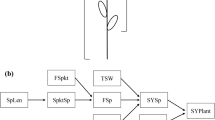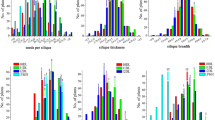Abstract
Cultivars of red clover (Trifolium pratense L.), an important forage crop in temperate regions, are often characterised by an unsatisfactory level of seed yield, leading to high production costs. This complex trait is influenced by many components and negatively correlated with other important traits, such as forage yield or persistence. Therefore, seed yield has proven to be difficult to improve. Thus, the objectives of this study were to assess association among seed yield components and to provide the basis for identifying molecular markers linked to QTLs for seed yield components to assist breeding for improved red clover cultivars. A total of 42 SSR and 216 AFLP loci were used to construct a molecular linkage map with a total map length of 444.2 cM and an average distance between loci of 1.7 cM. A total of 38 QTLs were identified for eight seed yield components. The traits seed number per plant, seed yield per head, seed number per head, head number per plant and percent seed set were highly correlated with seed yield per plant, and QTLs for several of these traits were often detected in the same genome region. Head number per plant may present a particularly useful character for the improvement of seed yield since it can easily be determined before seed maturity. In addition, two genome regions containing four or five QTLs for different seed yield components, respectively, were identified representing candidate regions for further characterisation of QTLs. This study revealed several key components which may facilitate further improvement of seed yield. The QTLs identified represent an important first step towards marker-assisted breeding in red clover.

Similar content being viewed by others
References
Abberton MT, Cogan NOI, Smith KF, Kearney G, Marshall AH, Williams A, Michaelson-Yeates TPT, Bowen C, Jones ES, Vecchies AC, Forster JW (2005) Quantitative trait locus analysis of morphogenetic and developmental traits in an SSR- and AFLP-based genetic map of white clover (Trifolium repens L.). In: Humphreys MO (ed) Proceedings of the 4th international symposium on the molecular breeding of forage crops and turf, a satellite workshop of the XXth International Grassland Congress, July 2005, Aberystwyth, Wales. Academic, Wageningen, pp 150
Andersen JR, Lübberstedt T (2003) Functional markers in plants. Trends Plant Sci 8:554–560
Armstead IP, Turner LB, King IP, Cairns AJ, Humphreys MO (2002) Comparison and integration of genetic maps generated from F2 and BC1-type mapping populations in perennial ryegrass. Plant Breed 121:501–507
Barrett BA, Baird IJ, Woodfield DR (2005) A QTL analysis of white clover seed production. Crop Sci 45:1844–1850
Belzile L (1991) The effect of soil type on red clover seed yield. Can J Plant Sci 71:1039–1046
Bert PF, Charmet G, Sourdille P, Hayward MD, Balfourier F (1999) A high-density molecular map for ryegrass (Lolium perenne) using AFLP markers. Theor Appl Genet 99:445–452
Boutin-Ganache I, Raposo M, Raymond M, Deschepper CF (2001) M13-tailed primers improve the readability and usability of microsatellite analyses performed with two different allele-sizing methods. BioTechniques 31:24–28
Brownstein MJ, Carpten JD, Smith JR (1996) Modulation of non-templated nucleotide addition by Taq DNA polymerase: primer modifications that facilitate genotyping. BioTechniques 20:1004–1010
Brummer EC, Bouton JH, Kochert G (1993) Development of an RFLP map in diploid alfalfa. Theor Appl Genet 86:329–332
Cannon SB, Crow JA, Heuer ML, Wang XH, Cannon EKS, Dwan C, Lamblin AF, Vasdewani J, Mudge J, Cook A, Gish J, Cheung F et al. (2005) Databases and information integration for the Medicago truncatula genome and transcriptome. Plant Physiol 138:38–46
Choi HK, Mun JH, Kim DJ, Zhu HY, Baek JM, Mudge J, Roe B, Ellis N, Doyle J, Kiss GB, Young ND, Cook DR (2004) Estimating genome conservation between crop and model legume species. Proc Natl Acad Sci USA 101:15289–15294
Cogan N, Smith K, Yamada T, Francki M, Vecchies A, Jones E, Spangenberg G, Forster J (2005) QTL analysis and comparative genomics of herbage quality traits in perennial ryegrass (Lolium perenne L.). Theor Appl Genet 110:364–380
Cregan PB, Jarvik T, Bush AL, Shoemaker RC, Lark KG, Kahler AL, Kaya N, Vantoai TT, Lohnes DG, Chung L, Specht JE (1999a) An integrated genetic linkage map of the soybean genome. Crop Sci 39:1464–1490
Cregan PB, Mudge J, Fickus EW, Danesh D, Denny R, Young ND (1999b) Two simple sequence repeat markers to select for soybean cyst nematode resistance conditioned by the rhg1 locus. Theor Appl Genet 99:811–818
Cumming BG, Steppler HA (1961) The control of growth and development in red clover (Trifolium pratense L.) IV: vegetative propagation and the use of growth regulators. Can J Plant Sci 836–848
Darvasi A, Weinreb A, Minke V, Weller JI, Soller M (1993) Detecting marker-QTL linkage and estimating QTL gene effect and map location using a saturated genetic map. Genetics 134:943–951
Deneufbourg F (2004) Seed yield of forage crop cultivars. Bull Semen 175:20–21
Echt CS, Kidwell KK, Knapp SJ, Osborn TC, Mccoy TJ (1994) Linkage mapping in diploid alfalfa (Medicago sativa). Genome 37:61–71
Flint-Garcia SA, Thornsberry JM, Buckler ES (2003) Structure of linkage disequilibrium in plants. Annu Rev Plant Biol 54:357–374
Freyre R, Skroch PW, Geffroy V, Adam-Blondon AF, Shirmohamadali A, Johnson WC, Llaca V, Nodari RO, Pereira PA, Tsai SM, Tohme J, Dron M et al. (1998) Towards an integrated linkage map of common bean. 4. Development of a core linkage map and alignment of RFLP maps. Theor Appl Genet 97:847–856
Herrmann D, Boller B, Widmer F, Kölliker R (2005) Optimization of bulked AFLP analysis and its application for exploring diversity of natural and cultivated populations of red clover. Genome 48:474–486
Isobe S, Klimenko I, Ivashuta S, Gau M, Kozlov NN (2003) First RFLP linkage map of red clover (Trifolium pratense L.) based on cDNA probes and its transferability to other red clover germplasm. Theor Appl Genet 108:105–112
Jones ES, Mahoney NL, Hayward MD, Armstead IP, Jones JG, Humphreys MO, King IP, Kishida T, Yamada T, Balfourier F, Charmet G, Forster JW (2002) An enhanced molecular marker based genetic map of perennial ryegrass (Lolium perenne) reveals comparative relationships with other Poaceae genomes. Genome 45:282–295
Kölliker R, Enkerli J, Widmer F (2005) Characterisation of novel microsatellite loci for red clover (Trifolium pratense L.) from enriched genomic libraries. Mol Ecol Notes DOI 10.1111/j.1471–8286.2005.01133.x
Lawrence MJ (1996) Number of incompatibility alleles in clover and other species. Heredity 76:610–615
Lehmann J, Briner HU (1998) Varieties of red clover and meadow fescue in tests. Agrarforschung 5(4):177–180
Mansur LM, Orf JH, Chase K, Jarvik T, Cregan PB, Lark KG (1996) Genetic mapping of agronomic traits using recombinant inbred lines of soybean. Crop Sci 36:1327–1336
Montardo DP, Dall’agnol M, Crusius AF, Paim NR (2003) Path analysis for seed production in red clover (Trifolium pratense L.). Braz J Anim Sci 32:1076–1082
Newbury HJ (2003) Plant molecular breeding. Blackwell, Oxford
Oliva RN, Steiner JJ, Young WC (1994) Red clover seed production: 2. Plant water status on yield and yield components. Crop Sci 34:184–192
Schauser L, Fredslund J, Heegard Madsen L, Sandal N, Stougaard J (2005) A computational pipeline for the development of comparative anchor tagged sequence (CATS) markers. In: Humphreys MO (ed) Proceedings of the 4th international symposium on the molecular breeding of forage crops and turf, a satellite workshop of the XXth International Grassland Congress, July 2005, Aberystwyth, Wales. Academic, Wageningen, pp 73–81
Schön CC, Utz HF, Groh S, Truberg B, Openshaw S, Melchinger AE (2004) Quantitative trait locus mapping based on resampling in a vast maize testcross experiment and its relevance to quantitative genetics for complex traits. Genetics 167:485–498
Steiner JJ, Smith RR, Alderman SC (1997) Red clover seed production: 4. Root rot resistance under forage and seed production systems. Crop Sci 37:1278–1282
Tavoletti S, Veronesi F, Osborn TC (1996) RFLP linkage map of an alfalfa meiotic mutant based on an F1 population. J Hered 87:167–171
Taylor NL, Quesenberry KH (1996) Red clover science. Kluwer, Dordrecht
Utz HF, Melchinger AE (2003) PLABQTL, version 1.2, a computer program to map QTL. Institute of Plant Breeding, Seed Science, and Population Genetics, University of Hohenheim, Stuttgart
Van Ooijen JW (2004) MapQTL 5, software for the mapping of quantitative trait loci in experimental populations. Kyazma B.V., Wageningen
Van Ooijen JW, Voorrips RE (2001) JoinMap 3.0, software for the calculation of genetic linkage maps. Kyazma B.V, Wageningen
Van Ooijen JW (1992) Accuracy of mapping quantitative trait loci in autogamous species. Theor Appl Genet 84:803–811
Visscher PM, Goddard ME (2004) Prediction of the confidence interval of quantitative trait loci location. Behav Genet 34:477–482
Vuylsteke M, Mank R, Antonise R, Bastiaans E, Senior ML, Stuber CW, Melchinger AE, Lubberstedt T, Xia XC, Stam P, Zabeau M, Kuiper M (1999) Two high-density AFLP linkage maps of Zea mays L.: analysis of distribution of AFLP markers. Theor Appl Genet 99:921–935
White RP, Murray S, Rohweider M (2000) Pilot analysis of global ecosystems: grassland ecosystems. World Resources Institute, Washington
Wricke G, Weber WE (1986) Quantitative genetics and selection in plant breeding. Walter de Gruyter, Berlin
Acknowledgements
The authors would like to thank Yvonne Häfele for technical assistance in the laboratory, Simone Günter, Philipp Streckeisen and Peter Tanner for support in the field, Eva Bauer of the State Plant Breeding Institute at the University of Hohenheim, Germany, for assistance with linkage mapping and QTL analysis and Sachiko Isobe of the National Agricultural Research Centre for Hokkaido Region, Japan for information on SSR primer sequences and map location. This study was funded by the breeding foundation DSP-BLW.
Author information
Authors and Affiliations
Corresponding author
Additional information
Communicated by T. Lübberstedt
Rights and permissions
About this article
Cite this article
Herrmann, D., Boller, B., Studer, B. et al. QTL analysis of seed yield components in red clover (Trifolium pratense L.). Theor Appl Genet 112, 536–545 (2006). https://doi.org/10.1007/s00122-005-0158-1
Received:
Accepted:
Published:
Issue Date:
DOI: https://doi.org/10.1007/s00122-005-0158-1




